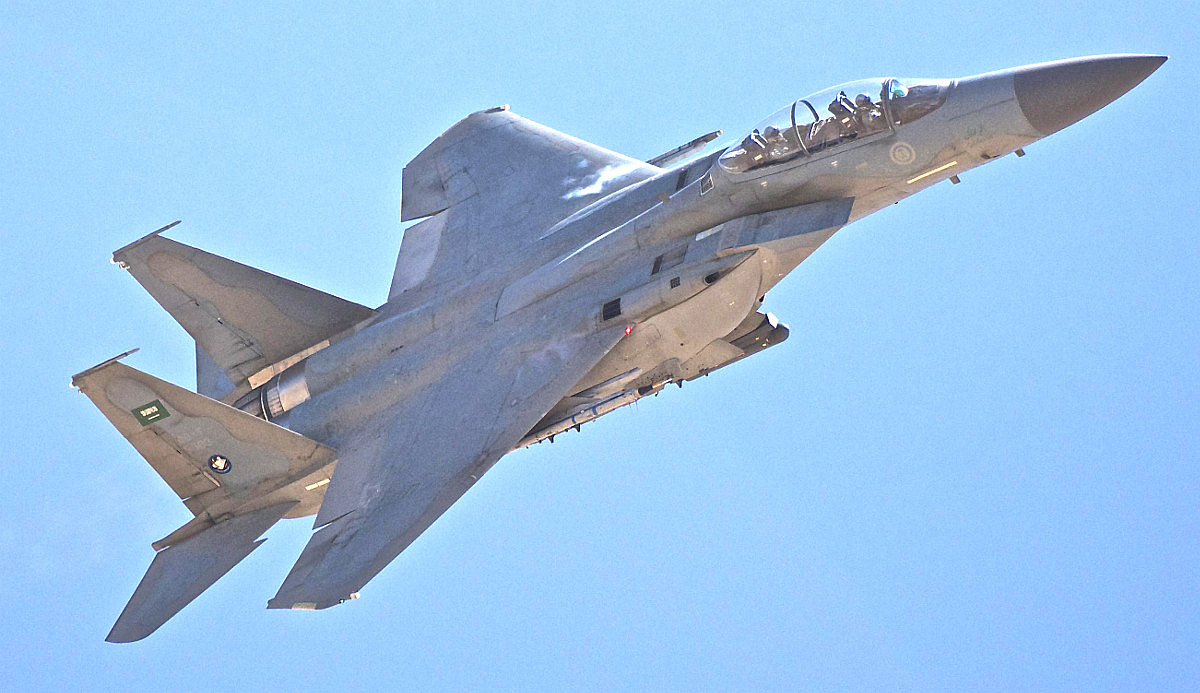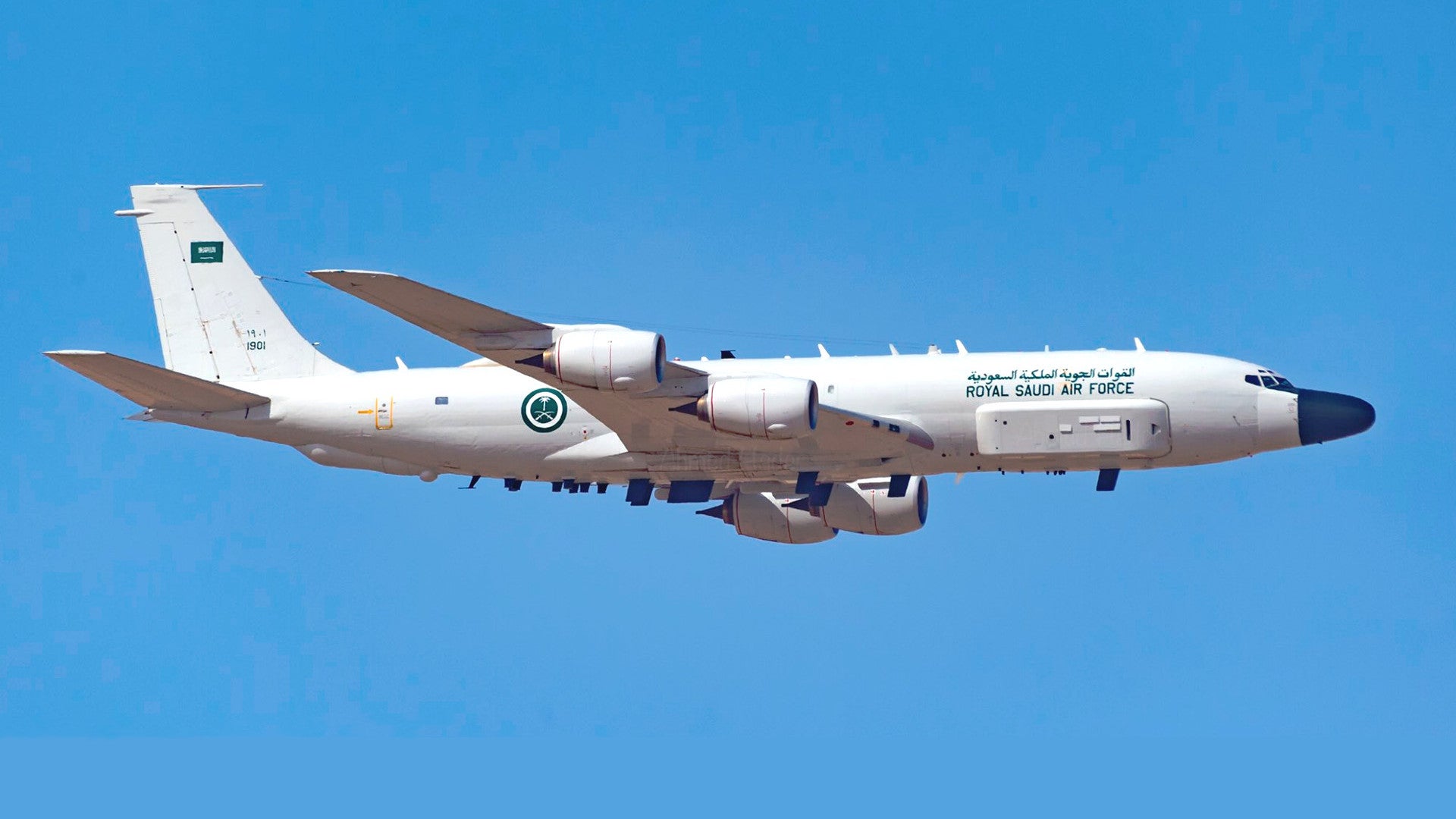During a ceremony to mark the end of its multi-national Joint Gulf Shield training exercise, Saudi Arabia has revealed that one of its airliner-sized RE-3A spy planes has received some extensive modifications. The aircraft now features a distinctive “hog nose,” similar to the U.S. Air Force’s RC-135V/W Rivet Joint, as well as other notable visual changes.
This particular RE-3A, also known as a Tactical Airborne Surveillance System (TASS), with the serial number 1901, is one of three RE-3 aircraft the Royal Saudi Air Force operates. This fleet reportedly consists of two RE-3A TASS types and a single RE-3B Improved Tactical Airborne Surveillance System (ITASS) aircraft, the latter of which carries the serial 1902.
All of these aircraft started life as KE-3As, an aerial refueling tanker that Boeing derived from the E-3A Sentry Airborne Warning and Control System, or AWACS. Saudi Arabia acquired a number of E-3A and KE-3A aircraft in the 1980s with help from the U.S. Air Force as part of the Peace Sentinel program.
The U.S. Air Force’s 645th Aeronautical Systems Group, a special projects office better known by the nickname Big Safari, helped manage the subsequent RE-3A and RE-3B conversions. According to U.S. Air Force records, there may be or have been a less intensive KE-3B TASS conversion that that retained some of the KE-3A’s aerial refueling capability. Saudi E-3 and KE-3 types were also present during the aerial review following the end of Joint Gulf Shield earlier in April 2018, which also included representatives from 24 other countries.
E Systems, which defense contractor Raytheon purchased in the 1990s, performed the initial RE-3 conversions. Based on a 2009 announcement from the Defense Security Cooperation (DSCA), the main Pentagon office charged with facilitating foreign military assistance, it appeared that L-3 had taken over responsibility for the program. Big Safari was still managing the program on Saudi Arabia’s behalf as of 2014, according to separate documents we at The War Zone obtained via the Freedom of Information Act.

The newest iteration of 1901, with its elongated nose and “chipmunk cheeks” on either side of the forward fuselage, appears almost identical to the latest RC-135V/Ws. On the Rivet Joint, at least in the past, these fairings on the side contain the powerful Automatic Electronic Emitter Locating System (AEELS), which the crew can use to geolocate signal emitters. The additional vents seen on the most recent versions, as well as the new Saudi RE-3A, could indicate they have an updated version of this equipment.
In addition, it has revised dorsal and ventral antenna arrays that closely mirror those on the U.S. Rivet Joints, as well as those on the U.K. Royal Air Force’s Airseeker. The latter aircraft is itself a derivative of the RC-135V/W.
It is almost certain that RE-3A’s new ventral antennas form the core of a signals intelligence suite, able to locate, categorize, and monitor a variety of hostile emissions. In U.S. Air Force service, one of the Rivet Joints’ primary missions is to help analysts build an accurate “electronic order of battle” with the locations and types of enemy radars, communications nodes, and other transmitters. They are also very capable of listening in on enemy communications chatter, which analysts and linguists onboard can then exploit in real time before passing on to other units.

The antennas along the spine of the fuselage likely belong to the aircraft’s own communications systems, which could include a number of different radios and data links to allow personnel on board to forward along information rapidly back to base or to troops on the ground. In 2009, the U.S. government approved the possible sale of approximately $530 million dollars worth of upgrades for the Saudi RE-3s, which focused heavily on upgrading the aircraft’s ability to transmit information reliably and securely.
The complete planned package included 10 AN/ARC-230 High Frequency Secure Voice/Data Systems, 25 AN/ARC-231 or 25 AN/ARC-210 Very High Frequency/Ultra High Frequency (VHF/UHF) Secure Voice/Data Systems, and four Multifunctional Information Distribution System-Low Volume Terminals (MIDS-LVT), as well as a variety of encryption systems. The work would also include improved LN-100GT combination inertial and GPS navigation systems and updates to existing ground terminals capable of receiving information from the planes.
“The proposed upgrade will enable the Royal Saudi Air Force (RSAF) to sustain their current capability, maintain interoperability with USAF and other coalition forces, and provide flexibility [sic] options for future growth,” DSCA said at the time. “The upgrade will enhance the RSAF’s ability to use a common architecture for efficiently communicating the gathered electronic data, within the RSAF and with other regional coalition forces.”

It is not clear from the announcement whether those improvements were slated to go into all three RE-3s or just the two RE-3A TASS aircraft. It’s also not clear whether or not 1901’s latest guise is a product of those modifications specifically or a separate upgrade program.
Whatever the case, the Saudis have undoubtedly employed the aircraft in their campaign against Iranian-backed Houthi rebels in Yemen. The RE-3’s signal scooping systems would be able to monitor the militants’ movements and gather additional information about their activities. With its real-time exploitation and communications capabilities, the crew could quickly pass that intelligence on to rapidly enable air and artillery strikes or aid in ground operations.
The Saudi-led coalition is also actively blockading ports in Houthi-controlled areas in order to curtail the ability of the group to resupply and acquire new and more advanced weapons and other equipment. The RE-3s could monitor transmissions to and from ships suspected of smuggling aid to the militants and help direct other air and naval forces to investigate targets of interest.
The new systems on 1901 could be important for monitoring developments with regards to the Houthis’ increasingly threatening ballistic missile, anti-ship cruise missile, and air defense capabilities. The revised configuration could be especially well suited to identifying radar-guided surface-to-air missile sites, which the Saudis claim the rebels are trying to establish with Iranian help.

But the multi-purpose system would be extremely valuable for the Saudis, especially given the relatively small number of RE-3s they have with which to conduct both tactical and strategic intelligence operations. The aircraft, and its ability to help build that aforementioned electronic order of battle, would be an essential capability in any large-scale regional conflict against an opponent with a more robust air defense network, particularly one involving Iran.
The U.S. Air Force already sends RC-135s of various types to peer into Iran from international airspace in the Persian Gulf on a routine basis. It is very possible that the Saudis might be interested in doing the same, if they aren’t already doing so to some degree.
Having the best possible sense of where Iran’s air defense nodes are situated would only improve the effectiveness of strikes, as well as the survivability of Saudi aircraft, if the two countries were to find themselves in an all-out conflict. The new RE-3 can only give the Royal Saudi Air Force an important edge in planning any such missions against any more conventional adversaries in the future. More immediately, the aircraft could be invaluable for keeping tabs on Iranian activities if they follow through with plans to establish more formal military bases in various countries the region.
If nothing else, the RE-3s already give the Royal Saudi Air Force an intelligence gathering platform that few others in the region possess. The new upgrades to 1901 can only further expand Saudi Arabia’s capabilities to conduct these missions.
Contact the author: jtrevithickpr@gmail.com
